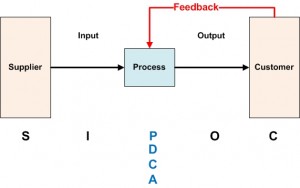Business process management (BPM) uses the process approach to achieve planned results, objectives, and your strategic vision. If you manage what you measure, then the process approach to business process management is the method used to determine what to measure, monitor, and take action on as you define your business processes.
What Is the Process Approach?
A well-defined business process is made up of a series of steps used to transform inputs into outputs. This business process transformation is depicted using a SIPOC diagram (see graphic).
SIPOC and PDCA
The SIPOC is an acronym for Supplier (S), Inputs (I), Process (P), Outputs (O), and Customer (C). Every input to your process has a supplier that provides it to the process. Your business process converts the inputs into an output for a customer.
The graphic also has a red “feedback?” line from the customer back to the process, which we use to compare the feedback to the processes objectives. Your customer’s feedback is critical to developing a controlled process. Without feedback and criteria you end up creating a “ballistic process” instead of a controlled process.
Ballistic processes blindly transform inputs into outputs. By adding process criteria, targets or objectives with feedback you transform a ballistic process into a controlled process. The goal of managing your business processes is to have controlled processes that are designed to achieve your strategy. Process feedback is what we measure, monitor and take action on to achieve control. Process criteria are what we compare the feedback to for that control.
PDCA and the Process Approach
PDCA is an acronym for Plan, Do, Check, Act. If we overlay the “P” of PDCA with the “P” of the SIPOC diagram we get an easy graphical acronym for all of the elements that need to be present to ensure a complete business process management definition.
The PDCA elements remind us that business processes need Plans (criteria), along with Doing (feedback data), an important Check step (comparison of feedback to the criteria), and finally Actions that are derived from the feedback we receive and how close we are to the criteria. The action step provides the needed correction to demonstrate the process is under control.
The Business Process Management Process Approach
Add the two together and the SIPOC + PDCA acronyms make a complete set that reminds us of all of the elements that are needed to demonstrate that business processes are managed. The process approach to BPM is all about creating controlled processes using PDCA and SIPOC to define, measure, monitor and control. That is business process management in action.












0 comments:
Post a Comment